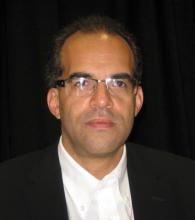ORLANDO – Younger patients with mantle cell lymphoma had significantly higher complete response rates after induction and better time to treatment failure after transplant with an experimental regimen adding high-dose cytarabine and R-DHAP to their treatment.
"Now we believe that the current gold standard for mantle cell lymphoma in young patients is the addition of high-dose Ara-C [cytarabine]," Dr. Olivier Hermine said on behalf of the European Mantle Cell Lymphoma Network during a press briefing at the American Society of Hematology annual meeting.
Dr. Hermine, head of the hematological department at Hôpital Necker in Paris, reported results of a randomized trial that compared outcomes in patients treated with alternating courses of the R-CHOP and R-DHAP regimens followed by myeloablative therapy containing high-dose cytarabine and autologous transplant with outcomes in a control arm in which patients were treated with six courses of R-CHOP plus myeloablation but without cytarabine or R-DHAP before transplant.
Among 420 patients with mantle cell lymphoma who were 65 years old or younger at the time of therapy, the combination of R-CHOP, R-DHAP, and high-dose cytarabine was associated with a 32% improvement in time to treatment failure (P = .0382).
In addition, 55% of those in the experimental arm had complete responses that were either confirmed or unconfirmed after induction, compared with 40% of those in the control group (P = .0028).
Overall response rates were similar between the groups, at 94% for R-CHOP/D-HAP and 90% for R-CHOP alone.
Longer follow-up will be needed to assess the effect on survival and on potential cure of mantle cell lymphoma. The goal of the next study will be to induce complete remissions, determined by minimal residual disease, before autologous stem-cell transplantation (ASCT), Dr. Hermine said.
Although long-term prognosis with mantle cell lymphoma historically has been poor, on the order of 3-4 years, a previous phase II study showed that a regimen of sequential R-CHOP (rituximab, cyclophosphamide, doxorubicin, vincristine, and prednisone) and R-DHAP (rituximab, dexamethasone, cytarabine, and cisplatin) followed by ASCT was associated with an overall response rate of 95% and a complete response rate of 61%. This translated into a median event-free survival of 83 months and an overall survival rate of 75% at 5 years (Delarue R. et al. ASH 2008 annual meeting. Abstract 581).
In the current study, the investigators compared six courses of R-CHOP followed by myeloablative radiochemotherapy consisting of 12 Gy total body irradiation (TBI) and two cycles of cyclophosphamide 60 mg/kg followed by ASCT with six alternating courses of R-CHOP (three times) and R-DHAP (three times) followed by a myeloablative regimen consisting of 10 Gy TBI, and four cycles of cytarabine 1.5 g/m2 and melphalan 140 mg/m2 followed by ASCT.
Previously untreated patients aged 65 years or younger with stage II-IV mantle cell lymphoma and an ECOG performance status of 0 or 1 were randomly assigned to receive one of the two regimens. The randomization was stopped in May 2010 after the experimental (R-CHOP/R-DHAP) arm met the prespecified efficacy stopping criteria. The primary end point was time to treatment failure. Secondary end points were response rates, overall survival, and safety.
A total of 497 patients in Germany, France, Poland, and Belgium were enrolled. Dr. Hermine presented data on 420 patients with documented responses. In both arms, the overall response was 97% among patients who went on to ASCT. But in a per-protocol analysis, patients in the experimental arm had significantly better time to treatment failure (hazard ratio favoring R-CHOP/R-DHAP 0.68, P = .0382).
A total of 77 disease-related events were recorded among the 212 evaluable patients in the standard therapy arm, vs. 44 in the experimental arm. There were eight deaths during remission in the R-CHOP group; six were transplant related, and two were from a second malignancy. In the R-CHOP/R-DHAP group 11 deaths occurred: 8 patients died from ASCT-related causes, and 3 from second cancers.
The relapse rates after achieving a complete response, unconfirmed complete response, or partial response were 49 in the control arm and 22 in the experimental arm. Durations of remission after transplant were significantly longer among patients in the experimental arm, with the median not yet reached, compared with 48 months for R-CHOP (P = .0059).
The experimental arm was associated with increased rates of grade 3 or 4 hematologic toxicities, renal toxicities, and grade 1 or 2 nausea and vomiting during induction, compared with the standard therapy arm.
For the pre-ASCT conditioning regimen, the R-CHOP/R-DHAP regimen induced more grade 3 or 4 mucositis, while the R-CHOP-alone arm was associated with higher grade 1or 2 liver toxicity and constipation.


